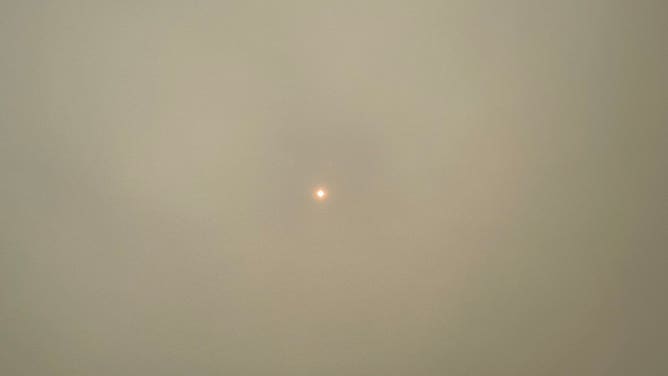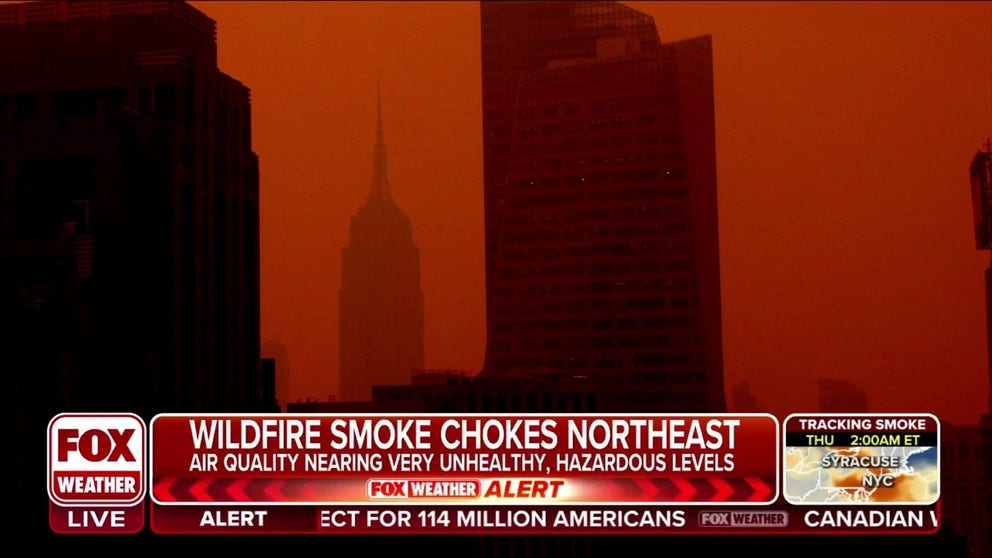New Jersey air quality improves after reaching hazardous levels from Canadian wildfire smoke
By late Thursday morning, AQI readings ranged from the upper 100s in northern New Jersey – still considered "unhealthy" levels – into the 200s in southern New Jersey, which is considered "very unhealthy".
Air quality deteriorating across New York, Northeast due to thick Canadian wildfire smoke
Thich smoke from wildfires burning in Canada has made its way into New York state and the Northeast dropping air quality levels to very unhealthy and hazardous levels.
Wildfire smoke descending from Canada swept across the northern U.S., including New Jersey, this week, creating unhealthy and even hazardous air quality at times.
The air quality has since greatly improved by Friday morning, with readings in the "moderate" range.
On the Air Quality Index that tops out at 500, Newark, New Jersey, was "hazardous" or a code maroon Wednesday afternoon, with 318 ppm – the worst in the state. Conditions continued to worsen throughout the day, with more areas reaching the most critical level on the AQI scale or remaining "unhealthy" with levels above 200 ppm.
By late Thursday morning, airnow.gov reported AQI readings ranging from the upper 100s in northern New Jersey – still considered "unhealthy" levels – into the 200s in southern New Jersey, which is considered "very unhealthy". The worst levels were near the Philadelphia and Wilmington, Delaware areas.
But by Friday morning, AQI readings had dropped under 100 in northern New Jersey – with even some "good" readings returning to the New York City suburbs. A lingering haze kept readings just over 100 in southern New Jersey and around Philadelphia.
Below are the cities across the Northeast currently experiencing the worst levels of air quality due to smoke from the Canadian wildfires.

(FOX Weather)
WHAT IS THE AIR QUALITY INDEX?
What did the wildfire smoke look like in New Jersey?

The smoke nearly covers the sun in the sky in Brick, New Jersey. (Image credit: @StephenFascia22/Twitter)
(FOX Weather)
Wednesday featured the worst air quality in New Jersey, as an orange and reddish glow was visible around much of the state.
In South Plainfield, New Jersey, the smoke-filled sky was reflected in the water at Spring Lake Park.
The haze blanketed the Newark Liberty International Airport and New Jersey Turnpike on Wednesday. The FAA issued a ground delay for New York area airports because of the smoke conditions in the region creating low visibility. Conditions worsened as the day went on Wednesday.
WHAT TO DO WHEN WILDFIRE SMOKE SMOTHERS YOUR AREA AND HOW TO KEEP YOUR HOME'S AIR CLEAN
As the wildfires continue to burn, the unhealthy air quality conditions are forecast to remain for at least a few more days as the slow-moving low-pressure system centered over the coastal region of New England is helping to bring in a northerly flow. A switch to southerly winds is expected to help clear out the smoke for the weekend.
